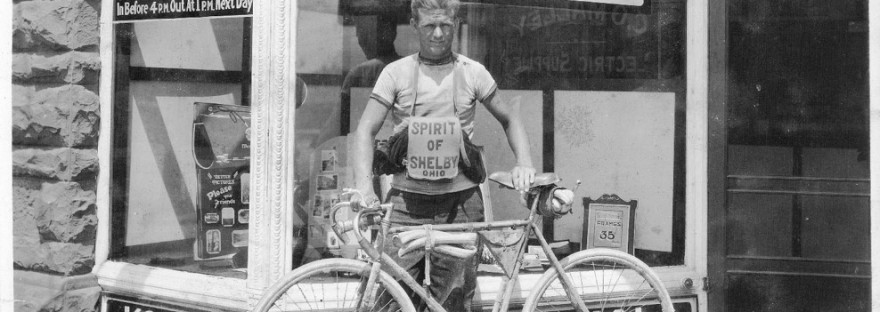Clarence “Whippet” Wagner (1900-1936)
Clarence “Whippet” Wagner put the fledgling Shelby Cycle Company in the news in 1927 when he broke his own transcontinental record, riding a Shelby Whippet bicycle.
Wagner was born in Terre Haute, Indiana in 1900 and served in the 69th Balloon Company with the Army Expeditionary Force in World War I. He first rode a bike long-distance, a captured German model, in 1918 while in France.
When he returned from the war, he began cycling in earnest. His first coast to coast ride in 1922 took 28 days and 5 hours. During a second California to New York trip, he would shave four days off his time.
In 1923, Wagner set his sights on a three-country record, riding through Canada, America and Mexico – 1,613 miles in 10 days, 7 ½ hours – shaving two days off the previous record despite tire troubles. All but 20 miles were over dirt roads.
Wagner attended Indiana State Normal University and paid for his education by delivering newspapers. With a bicycle with a specially made trailer, he could carry more than 200 pounds of newspapers on his daily route.
Wagner again rode coast to coast in 1927, from Newport Beach to Atlantic City. He traveled 3,169 miles in 20 days, 17 hours, breaking his own transcontinental record. Wagner lived in Shelby while training on Shelby Cycle Company’s newest bike, a racing model called the Whippet.
Wagner averaged about 160 miles in 14 hours a day during the record-breaking trip, with Shelby Cycle president H. Clyde Brokaw and Dudley Seltzer setting the pace by automobile while providing a windbreak for the rider. The Whippet held up with no mechanical issues.
Wagner telegraphed his progress to the cycle company at points. He rode through 107 degree weather in the Mohave Desert, rode on railroad ties at points, suffered nosebleeds from high altitude rides, dragged his bike 10 miles through the mud, encountered hundreds of miles of rain and hailstorms, and forded streams 3 feet deep.
All told, he rode cross-country three times and from Canada to Mexico twice. At one point, Wagner estimated he had ridden about 85,000 miles on bicycles.
Wagner eventually went to work in the mines in Terre Haute. He died in a mine explosion in 1936.
© Christina Yetzer Drain

